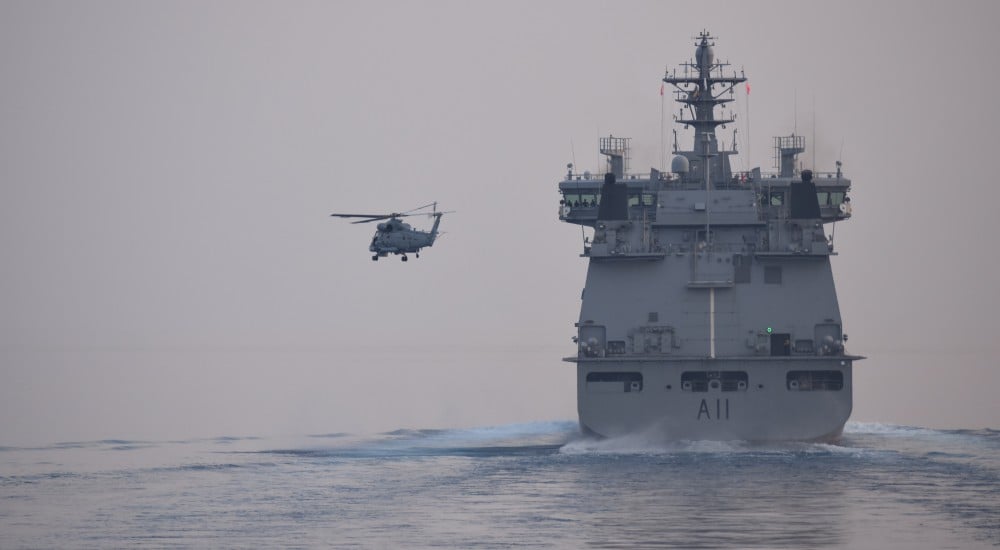U.S. Sailors, Marines join partners for Biennial Exercise in Philippine Sea

Forward-deployed U.S. sailors and Marines are training alongside the Japan Maritime Self-Defense Force and other allied militaries in the Philippine Sea as part of Annualex, a multilateral exercise held every other year.
Led by Japanese destroyer carrier JS Kaga (DDH-184), the exercise kicked off Monday with the goal of refining existing combat interoperability capabilities, enhancing readiness across platforms and deterring regional instability and aggression, officials said.
“This year’s Annualex focuses on enhancing the Japan and U.S. bilateral alliance within a multilateral context through maritime communication tactics, anti-submarine warfare operations, air warfare operations, replenishment-at-sea and more,” reads U.S. 7th Fleet news release.
Representing the U.S. this year are: cruiser USS Robert Smalls (CG-62), destroyer USS Shoup (DDG-86), dry cargo ships USNS Amelia Earhart (T-AKE-6) and USNS Wally Schirra (T-AKE-8), fleet-oiler USNS Tippecanoe (T-AO-199), a submarine, P-8A Poseidon Maritime Patrol Aircraft (MPA) and U.S. Marine Corps F-35B Lightning II assigned to the “Bats” of Marine Fighter Attack Squadron (VMFA) 242. Imagery released Monday by the U.S. Defense Department also shows F-35Cs assigned to the “Argonauts” of Strike Fighter Squadron (VFA) 147 taking part in the drills. VFA-147 forms part of Carrier Air Wing (CVW-5) assigned to aircraft carrier USS George Washington (CVN-73).
Japan will contribute destroyers and a submarine.
This year’s iteration also includes participation for the first time from France, which is joining Australia, Canada and New Zealand alongside the U.S. and Japan.
France is deploying surveillance frigate FS Prairial (F731) for the drills. The frigate is based in French Polynesia. The Royal Canadian Navy’s (RCN) offshore patrol vessel HMCS Max Bernays (AOPV432) will join the drills, as well. Max Bernays is the only RCN ship deployed in the region.
Australian and New Zealand forces will participate while also conducting routine surveillance on North Korean maritime sanctions violations. Fleet oiler HMNZS Aotearoa (A11), as well as P-8A Maritime Patrol Aircraft from both countries, will join Annualex between surveillance missions.

Other participating forces will include the Royal Australian Navy (RAN) and Air Force (RAAF), Royal Canadian Air Force (RCAF), French Navy and the Royal New Zealand Air Force (RNZAF).
It is unclear how long Annualex will run. In 2023, Annualex spanned 11 days, from Nov. 10-20.
“This exercise will strengthen the ties between France, Japan and the United States, following on from the Pacific Steller exercise that took place in February of this year, bringing together 15 units around the French, American and Japanese carrier battle groups,” reads a French Ministry of the Armed Forces news release.
Coinciding with Annualex is Japan’s Self-Defense Force 2025 Joint Exercise, which is taking place at military bases across Japan. U.S. and Australian armed forces will participate in part of the exercise, according to a Japan Joint Staff Office (JSO) news release.
The JSDF will deploy approximately 52,300 personnel, 4,180 vehicles, 60 ships and 310 aircraft. The U.S. will contribute 5,900 personnel and another 230 troops from the Australian Defense Force will participate. No details were given on U.S. assets participating in the drills.
Troops will drill on anti-ship attack training using Japan’s mobile anti-ship missile launchers, as well as amphibious and airborne operations in Japan’s southwest region. Base security exercises will be conducted on Japanese and U.S. military bases. Japan’s ground forces will rehearse deployments via rotary wing aircraft and sea transportation, partnering with U.S. Navy amphibious ships. A Japanese submarine will also dock at U.S. port facilities to conduct a replenishment.
The exercise will conclude Oct. 31. (Dzirhan Mahadzir/USNI News)



